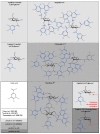The ups and downs of tannins as inhibitors of poly(ADP-ribose)glycohydrolase
- PMID: 21343889
- PMCID: PMC6259645
- DOI: 10.3390/molecules16021854
The ups and downs of tannins as inhibitors of poly(ADP-ribose)glycohydrolase
Abstract
DNA damage to cells activates nuclear poly(ADP-ribose)polymerases (PARPs) and the poly(ADP-ribose) (PAR) synthesized is rapidly cleaved into ADP-ribose (ADPR) by PAR glycohydrolase (PARG) action. Naturally appearing tannin-like molecules have been implicated in specific inhibition of the PARG enzyme. This review deals with the in vitro and in vivo effects of tannins on PAR metabolism and their downstream actions in DNA damage signaling.
Figures


References
Publication types
MeSH terms
Substances
LinkOut - more resources
Full Text Sources
Other Literature Sources

